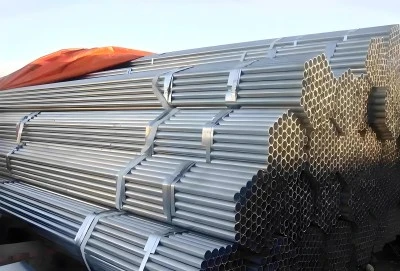Checking ERW galvanized pipe requires a combination of visual inspection and professional testing methods. ERW (Electric Resistance Welded) galvanized pipes are widely used in various industries due to their corrosion resistance and durability. To ensure the quality of these pipes, it's crucial to examine the zinc coating uniformity, identify surface defects, assess weld seam quality, and conduct professional tests when necessary.
|
|
|
Visual Inspection: Key Surface Indicators
Examining Zinc Coating Uniformity and Thickness
The first step in checking ERW galvanized pipe is to examine the zinc coating. A high-quality galvanized pipe should have a uniform, smooth surface with a slight sheen. Run your hand along the pipe's surface; it should feel consistently smooth without any rough patches or irregularities. Pay close attention to the color, which should be a consistent silver-gray throughout the entire pipe length.
To assess the coating thickness, you can use a magnetic thickness gauge. This non-destructive tool provides accurate measurements of the zinc layer. For most applications, a coating thickness between 45 and 100 microns is considered standard. However, specific requirements may vary depending on the intended use and environmental conditions.
Identifying Surface Defects and Imperfections
Carefully inspect the pipe's surface for any visible defects. Common issues to look out for include:
- Bare spots: Areas where the zinc coating is missing or thin
- Blisters: Raised areas that may indicate poor adhesion of the zinc coating
- Rust spots: Signs of corrosion that could compromise the pipe's integrity
- Dents or gouges: Physical damage that may affect the pipe's performance
Use a magnifying glass to examine any suspicious areas more closely. Minor imperfections may be acceptable, but significant defects could indicate subpar manufacturing processes or damage during handling and transportation.
Assessing Weld Seam Quality in ERW Pipes
The weld seam is a critical area in ERW pipes. Inspect the seam along the entire length of the pipe, looking for any irregularities or inconsistencies. A high-quality weld seam should be:
- Straight and continuous
- Free from cracks, pinholes, or overlaps
- Smooth and flush with the pipe surface
- Evenly coated with zinc, matching the rest of the pipe
If you notice any deviations in the weld seam, such as bulges, depressions, or areas with different coloration, it may indicate potential weaknesses in the pipe's structure.
Professional Quality Testing (For Critical Applications)
Non-Destructive Testing Methods for ERW PipesFor applications where pipe integrity is crucial, such as in oil and gas transportation or high-pressure water systems, professional non-destructive testing (NDT) methods are essential. These techniques allow for thorough inspection without damaging the pipe. Common NDT methods for ERW galvanized pipes include:
- Ultrasonic Testing (UT): Uses high-frequency sound waves to detect internal flaws and measure wall thickness
- Eddy Current Testing: Identifies surface and near-surface defects in the pipe wall
- Magnetic Particle Inspection: Detects surface and slightly subsurface discontinuities in ferromagnetic materials
- Radiographic Testing: Uses X-rays or gamma rays to reveal internal defects and weld quality
These tests should be performed by certified technicians using calibrated equipment to ensure accurate results.
Corrosion Resistance Evaluation Techniques
To assess the corrosion resistance of ERW galvanized pipes, several specialized tests can be conducted:
- Salt Spray Test: Exposes pipe samples to a corrosive salt solution to evaluate coating performance
- Accelerated Weathering: Simulates long-term exposure to environmental factors like UV radiation and moisture
- Electrochemical Impedance Spectroscopy: Measures the pipe's resistance to corrosion in various electrolytes
These tests provide valuable data on how the pipes will perform in challenging environments, such as marine applications or chemical processing plants.
Mechanical Properties Testing for Structural Integrity
For structural applications, it's crucial to verify the mechanical properties of ERW galvanized pipes. Key tests include:
- Tensile Strength Test: Measures the pipe's ability to withstand longitudinal stress
- Yield Strength Test: Determines the point at which the pipe begins to deform plastically
- Flattening Test: Assesses the pipe's ductility and weld integrity
- Hydrostatic Pressure Test: Evaluates the pipe's ability to withstand internal pressure without leaking
These tests ensure that the pipes meet the required strength and performance standards for their intended use in structural projects.
Certification and Standards: Ensuring Quality
Understanding ASTM and API Standards for ERW PipesWhen checking ERW galvanized pipes, it's essential to be familiar with relevant industry standards. The American Society for Testing and Materials (ASTM) and the American Petroleum Institute (API) provide comprehensive guidelines for pipe manufacturing and testing. Key standards include:
- ASTM A53: Specification for Pipe, Steel, Black and Hot-Dipped, Zinc-Coated, Welded and Seamless
- ASTM A123: Standard Specification for Zinc (Hot-Dip Galvanized) Coatings on Iron and Steel Products
- API 5L: Specification for Line Pipe
These standards outline specific requirements for chemical composition, mechanical properties, dimensions, and testing procedures. Familiarize yourself with the applicable standards for your project to ensure the pipes meet or exceed the necessary quality benchmarks.
Verifying Manufacturer Certifications and Test Reports
Reputable manufacturers provide certification documents and test reports for their ERW galvanized pipes. When reviewing these documents, pay attention to:
- Material Test Reports (MTR): Verify chemical composition and mechanical properties
- Coating Thickness Reports: Ensure consistent galvanization across pipe batches
- Non-Destructive Examination (NDE) Reports: Confirm the absence of critical defects
- Quality Management System Certifications: Look for ISO 9001 or equivalent certifications
Cross-reference the information in these documents with the actual pipes you're inspecting to ensure consistency and compliance with project specifications.
Third-Party Inspection: When and Why It's Necessary
For large-scale projects or applications where pipe failure could have severe consequences, third-party inspection services are invaluable. Independent inspectors can provide:
- Unbiased quality assessments
- Verification of manufacturer claims
- Additional testing and inspection services
- Documentation for regulatory compliance
Consider engaging third-party inspectors for critical infrastructure projects, offshore installations, or when dealing with new or unfamiliar suppliers. Their expertise can help identify potential issues early and ensure that all pipes meet the required quality standards.
Properly checking ERW galvanized pipes is crucial for ensuring the success and longevity of your projects. By combining visual inspection techniques with professional testing methods and adhering to industry standards, you can confidently select high-quality pipes that meet your specific requirements. Remember that thorough inspection and quality assurance are investments that pay dividends in the form of reduced maintenance costs, improved safety, and enhanced project performance over time.
ERW Galvanized Pipe For Sale
Hebei Longma Group offers top-quality ERW galvanized pipes for your projects. With advanced production equipment imported from Germany and independently developed technologies, we ensure superior product quality. Our team of over 300 employees, including 60+ technical experts, guarantees professional service and support. We utilize comprehensive testing facilities, including ultrasonic flaw detectors and X-ray equipment, to maintain strict quality control. Experience fast delivery with standard thickness pipes ready in as little as 7 days. We hold various certifications, including API 5L, ISO 9001, and ISO 14001, ensuring compliance with international standards. Our competitive pricing is achieved through long-term partnerships with raw material suppliers and efficient production processes. For galvanized pipes meeting API 5L, ASTM A53, EN10210, or AS/NZS 1163 standards, with outer diameters from 60.3-1422mm and wall thickness from 6.02-50.8mm, contact us at info@longma-group.com.














